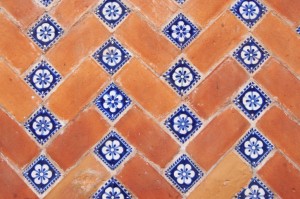A Tale of Two Talaveras
Spain
 The Spanish city of Talavera de la Reina is known as the City of Pottery. Moors brought techniques and designs of Islamic pottery to Talavera in the 12th century. Known as majolica, the craftsmen of Talavera embraced this kind of pottery and went on to add their own techniques and designs. Majolica was further influenced by nearby Italians before the formation of guilds standardized production and regulated quality. By the 16th century, Talavera de la Reina was enjoying a Golden Age of pottery, and its ornate works were celebrated throughout Europe and exported to the Americas. The kilns in Talavera produced china sets and tiles that adorned palaces and mansions around the world. Today these ceramics can be seen in the Spanish Royal Palace in Madrid and in the Monastery of El Escorial. Talavera’s Golden Age continued through the 17th century as its potters cultivated a high style that often depicted scenes of gallantry, hunting, and allegories. In the 18th and 19th centuries, Talavera’s style softened and became more popular, focusing on decorative motifs, simpler lines and borders, and broader strokes. Today Talavera hosts an International Ceramics Biennial and remains home to numerous ceramics workshops.
The Spanish city of Talavera de la Reina is known as the City of Pottery. Moors brought techniques and designs of Islamic pottery to Talavera in the 12th century. Known as majolica, the craftsmen of Talavera embraced this kind of pottery and went on to add their own techniques and designs. Majolica was further influenced by nearby Italians before the formation of guilds standardized production and regulated quality. By the 16th century, Talavera de la Reina was enjoying a Golden Age of pottery, and its ornate works were celebrated throughout Europe and exported to the Americas. The kilns in Talavera produced china sets and tiles that adorned palaces and mansions around the world. Today these ceramics can be seen in the Spanish Royal Palace in Madrid and in the Monastery of El Escorial. Talavera’s Golden Age continued through the 17th century as its potters cultivated a high style that often depicted scenes of gallantry, hunting, and allegories. In the 18th and 19th centuries, Talavera’s style softened and became more popular, focusing on decorative motifs, simpler lines and borders, and broader strokes. Today Talavera hosts an International Ceramics Biennial and remains home to numerous ceramics workshops.
Mexico
The techniques involved in creating majolica pottery arrived in Mexico from Talavera very early in Mexico’s colonial period. Although there are several theories about precisely how majolica production came to take root in the New World, many believe it was Spanish monks seeking adornment for their monasteries that either began producing ceramics or sponsored artisans from Spain. The first Spanish ceramics artisans in Mexico taught their craft to indigenous potters to keep up with demand. These potters incorporated their own pre-Hispanic techniques and designs into an already multi-cultural art form to create a new tradition that came to be known as Talavera Poblana to distinguish it from Spanish Talavera pottery. By 1580, the Mexican city of Puebla became the center of Talavera Poblana production and remains so today.
Talavera Tile:An Islamic Spanish Italian Mexican American Tradition
The Mexican government regulates the creation of today’s Talavera ceramics. Only pottery from Puebla and the nearby communities of Atlixco, Cholula and Tecali can call itself true Talavera. Talavera must also use specific clay and traditional glazes. Its natural pigment dyes can only be specific shades of blue, yellow, black, green, orange, and mauve. True Talavera’s hand-painted designs appear blurry because the paint fuses slightly with the glaze, and the glaze only covers the decorative top of a tile, exposing the terracotta beneath.
Anyone interested in incorporating this rich tradition into their home should see and feel these intricate and beautiful tiles for themselves. The knowledgeable staff at Mission Tile West are happy to answer any questions you may have regarding Talavera tile, the long history behind its many designs, and how best to install and care for this unique, durable, beautiful art form.
